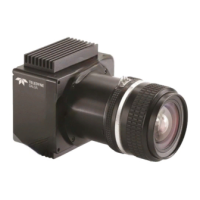47 Piranha 2 User’s Manual
03-032-00493-14 Teledyne DALSA
4.2 Optical Interface
Depending upon resolution the cameras can be ordered with different lens mounts. The
following table provides this information.
Lens Mounts
All C-mount and F-mount adapters have the appropriate back focal distance for the lens
type being used. Ensure that the image circle diameter of the lens to be used is as great as
the length of the imaging region. The following table provides information regarding the
lens mount used and the back focal distance. The M72x0.75 lens adapter originated from
the high-end photography standard. Distances to its inner flat surface and the outer flat
surface are provided.
Detailed mechanicals, including front plate opening sizes, and the distance from the
sensor die to the opening, can be found in section 4.1 Mechanical Interface.
Note: Lens manufacturers have readily available lens mounts and lenses to adapt to the
M72x0.75 adapter available on the 6K and 8K cameras.
Illumination
The amount and wavelengths of light required to capture useful images depend on the
particular application. Factors include the nature, speed, and spectral characteristics of
objects being imaged, exposure times, light source characteristics, environmental and
acquisition system specifics, and more. The Knowledge Center page on our website,
www.teledynedalsa.com/ mv/ knowledge/ appnotes.aspx, has an introduction to this
potentially complicated issue posted. See ―Rad iom etry and Photo Resp onsivity‖ and
"Sensitivities in Photometric Units" in the CCD Technology Primer found under the
Application Support link.
It is often more important to consider exposure than illumination. The total amount of
energy (which is related to the total number of photons reaching the sensor) is more
important than the rate at which it arrives. For example, 5J/ cm
2
can be achieved by
exposing 5mW/ cm
2
for 1ms just the same as exposing an intensity of 5W/ cm
2
for 1s.

